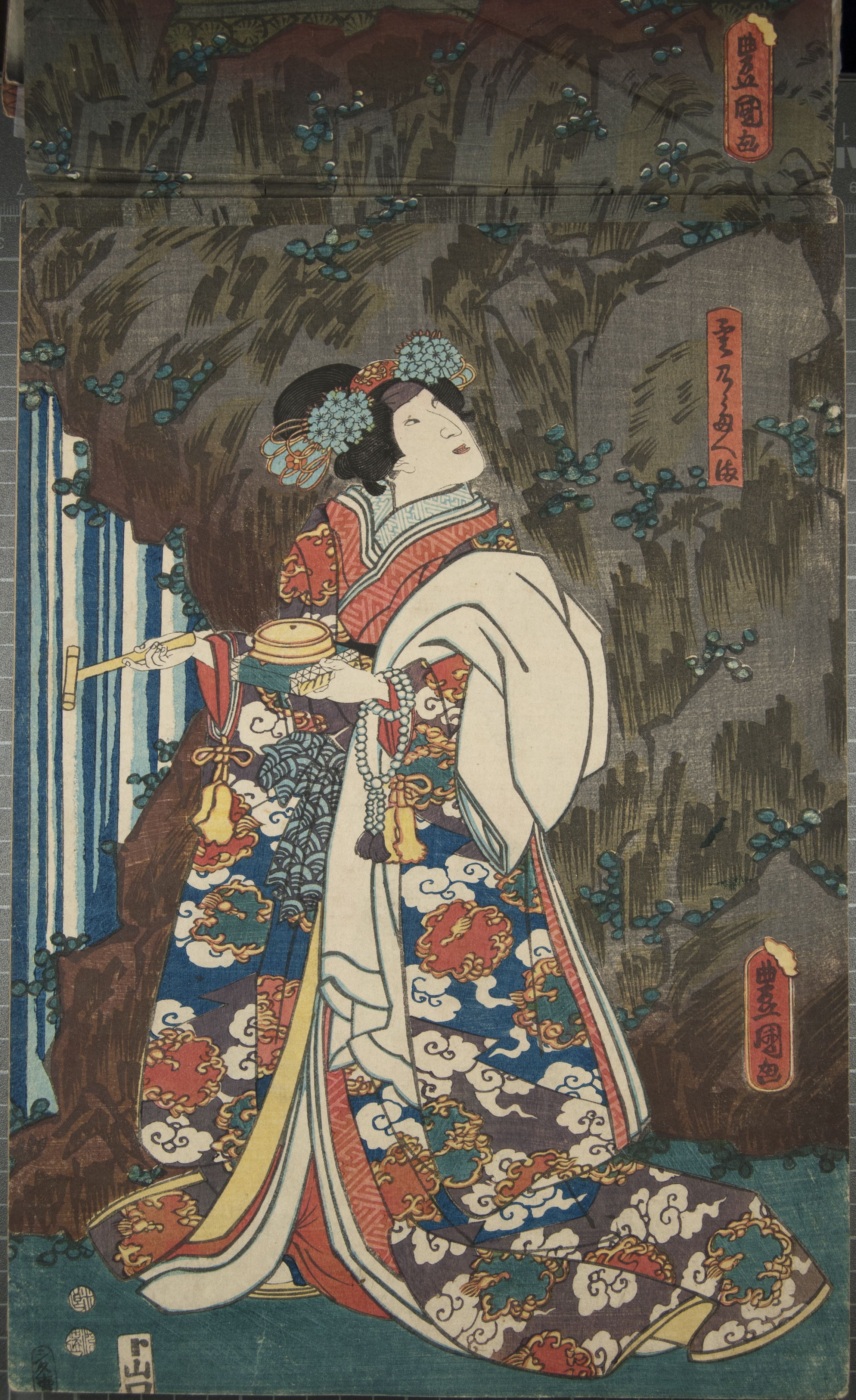
| ARC浮世絵ポータルデータベース/Ukiyo-e Portal Database詳細情報表示 | 7件の内7件目を表示中 | ImageNote | UserMemo |
|
クリックして画像のみのウィンドウを別々に開く→ |
縦A | 縦B | 縦C | 縦D | 縦E | 縦F | 横G | 横H |
| 同板作品表示 | ←前の作品 | 新規検索 |
| サムネイル一覧 | 簡易情報付一覧 | ArtWiki | English» |
| AcNo. CoGNo. JA13035 AlGNo. JA13035 |
| 絵師: 豊国〈3〉 (Toyokuni (3)) 落款印章: 豊国画(年玉枠) / Toyokuni ga in red toshidama cartouche 絵師検索 画中人名: 雲のたへま」 初代坂東しうか / Bandô Shûka I as Kumo no Taema 人物検索 |
| 判型: 大判/錦絵 / ôban nishikie 寸法: 37.5 x 26 続方向: 竪 作品位置: 001 枚組の 001 番目 02 枚続の 02 枚目 |
| Col重複: 1 All重複: 1 |
| 板元文字: 卜山口 板元備考: 下売 / shita uri |
| 版印1 板元1 板元名1: 山口屋 藤兵衛 / Yamaguchiya Tôbei (Kinkôdô) |
| 出版年月: ()・ 同時作品 |
|
作品名:
雲のたへま
Kumo no Taema Kumo no Taema |
| 場所: 江戸・ 市村 興行年表 |
|
興行名:
恋模様振袖妹背
こいもようふりそでめおと / Koi Moyô Furisode Meoto
外題: 橘牡丹皐月夜話 はなきょうだいさつきのよばなし / Tachibana botan satsuki banashi 所作題: 鳴神 なるかみ / narukami |
| 配役: 雲のたへま」初代坂東しうか / Bandô Shûka I as Kumo no Taema 役者DB |
| 組解説:Koi moyō furisode meoto wellknown as Narukami, the thunder god. Ir is a classic kabuki play that tells the story of a powerful Buddhist saint. Angered by the Emperor's refusal to dedicate a temple to him, Narukami uses his power to imprison the Dragon Gods thus preventing rain from falling on the earth. The scene shifts to Narukami's retreat above towering rock cliffs adjoining a waterfall. While Narukami meditates, Taema, an astonishingly beautiful woman, calls to the God Fudo for aid. Unbeknownst to Narukami, Taema has been sent by the Emperor to seduce him and release the Dragon Gods. Claiming to be recently widowed, Taema says that she has come to the shrine to cleanse herself from carnal memories so she can start a new life. Narukami becomes suspicious of her motives, but his hesitation is soon overcome as he is seduced by Taema's beauty and asks her to marry him. Following their nuptials, Narukami falls asleep, and Taema releases the Dragon Gods. Discovering the treachery, Narukami transforms into a terrible Thunder God vowing to pursue Taema in revenge for her deception. https://sites.google.com/site/utnarukami/narukami-2/plot-summary#:~:text=Narukami%20%2D%20The%20Thunder%20God%20is,from%20falling%20on%20the%20earth. 下売 / shita uri seal (lit. low sale seal) appears in actor prints from 1850/1 to 1853/3. The purpose remains unclear. The position of the ‘shita-uri’ seal is mostly next to the signature or the publisher seal. This seal has been documented between II/1850 and II/1853. It was probably used for some years after the relaxation of the severe Tenpô Reforms (1842-47) that banned prints of theatrical subjects. Kabuki depiction had progressed from historical scenes with actors as heroes to flagrant depictions of kabuki, marked only with the "shita-uri" seal that meant such prints were not to be displayed openly in shops, where they might receive the notice of an official (i.e. low sale, or under the counter). Andreas Marks however, mentions that the term ‘shita-uri’ was in use in other business as well, for example in the fish wholesale where it meant a “negotiated transaction” between two parties. Marks raises the question if this seal was not a new constraint to the market but rather a way of liberalizing it by allowing publishers, with a restricted and limited number of prints, to get away from fixed prices and be more flexible in their pricing. (Andreas Marks, Publishers of Japanese Woodblock Prints: A Compendium, Hotei, 2011, p. 479-480). |
| 系統分類: 役者絵 / yakushae 画題: |
| 所蔵:The Complutense University of Madrid (UCM) 資料部門: 浮世絵 |
| Permalink: |

|
|
所蔵資料の利用に関しましては所蔵資料ご利用ガイドをご覧ください。 |